

|
| Apache Geronimo > Index > Development > XML Schemas > Apache Geronimo v2.1 XML Schemas | User List | Dev List | Wiki | Issue Tracker |
|
Documentation for geronimo-naming-1.2Table of Contents
Schema Document Properties
Declared Namespaces
Schema Component Representation
<xsd:schema
targetNamespace="http://geronimo.apache.org/xml/ns/naming-1.2" elementFormDefault="qualified" attributeFormDefault="unqualified" version="1.0">
<xsd:import
namespace="http://geronimo.apache.org/xml/ns/deployment-1.2" schemaLocation="geronimo-module-1.2.xsd"/>
... </xsd:schema>Global DeclarationsElement: abstract-naming-entry
Logical Diagram

XML Instance Representation
<gernaming:abstract-naming-entry/>
Diagram
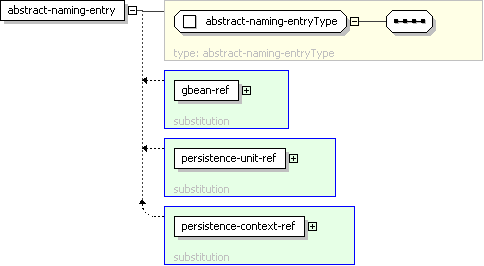
Schema Component Representation
<xsd:element
name="abstract-naming-entry" type="
gernaming:abstract-naming-entryType
" abstract="true"/>
Element: cmp-connection-factory
Logical Diagram
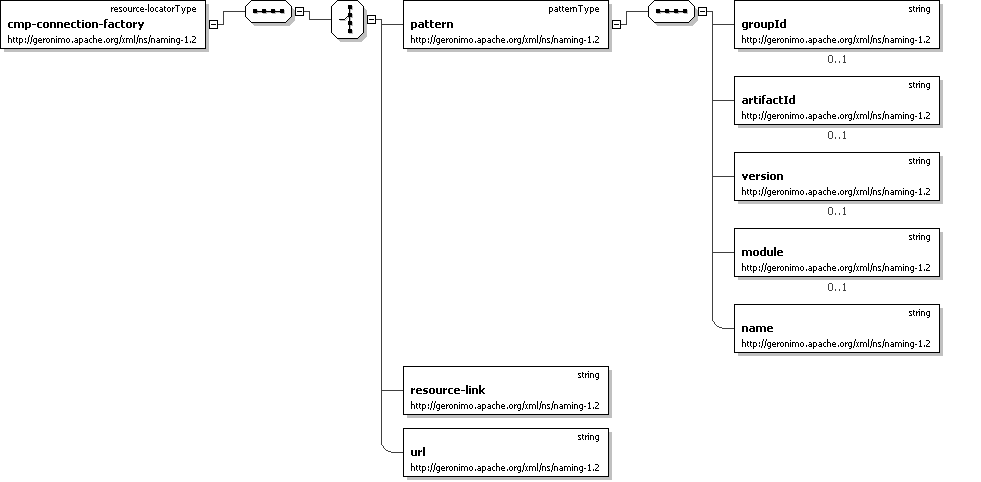
XML Instance Representation
<gernaming:cmp-connection-factory>
Start Choice [1] <gernaming:pattern>
gernaming:patternType
</gernaming:pattern> [1]
'The element pattern is used to provide additional selection criterion for resources if multiple resources with same resource-name exists in dependency modules. The pattern mapped should result in single resource.' <gernaming:resource-link>
xsd:string </gernaming:resource-link> [1]
'The element resource-link is used to identify the JDBC, JMS, or JavaMail resource specified in all the dependency modules. This name should match the connectiondefination-instance/name defined in resource adapter deployment descriptor. If the name is not unique the pattern element will be used to uniquely identify this resource.' <gernaming:url>
xsd:string </gernaming:url> [1]
End Choice
'The element url is used to identify the resources of type java.net.URL deployed in all the dependency modules. If the url doesn\'t map to unique resource the pattern element will be used to uniquely identify this resource.' </gernaming:cmp-connection-factory>
Diagram

Schema Component Representation
Element: ejb-local-ref
Logical Diagram
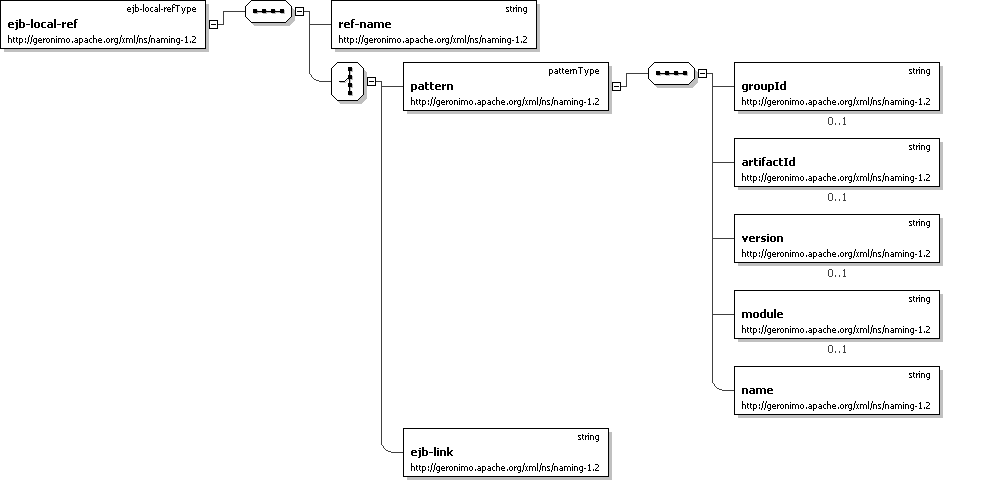
XML Instance Representation
<gernaming:ejb-local-ref>
<gernaming:ref-name>
xsd:string </gernaming:ref-name> [1]
Start Choice
[1]
'The element ref-name is used to identify this local ejb reference. This name should be unique in a module and will be used by application to as a part of JNDI name for the referenced ejb. The JNDI name used will be \"java:/comp/env/ref-name. It should map to the \"ejb-ref-name\" provided in deployment descriptor.' <gernaming:pattern>
gernaming:patternType
</gernaming:pattern> [1]
'The element pattern is used to provide additional selection criterion for local ejb\'s if multiple local ejb\'s with same ejb-link exists in EAR or dependency modules. The pattern mapped should result in single local EJB.' <gernaming:ejb-link>
xsd:string </gernaming:ejb-link> [1]
End Choice
'The element ejb-link is used to identify the local ejb specified in same EAR or dependency modules. This name should match the ejb-name defined in EJB deployment descriptor. If the name is not unique the pattern element will be used to uniquely identify this local ejb.' </gernaming:ejb-local-ref>
Diagram

Schema Component Representation
Element: ejb-ref
Logical Diagram

XML Instance Representation
<gernaming:ejb-ref>
<gernaming:ref-name>
xsd:string </gernaming:ref-name> [1]
Start Choice
[1]
'The element ref-name is used to identify this remote ejb reference. This name should be unique in a module and will be used by application as a part of JNDI name for the referenced ejb. The JNDI name used will be \"java:/comp/env/ref-name. It should map to the \"ejb-ref-name\" provided in deployment descriptor.' <gernaming:pattern>
gernaming:patternType
</gernaming:pattern> [1]
'The element pattern is used to provide additional selection criterion for remote ejbs if multiple ejbs with same ejb-link exists in EAR or dependency modules. The pattern mapped should result in single remote EJB.' <gernaming:ns-corbaloc>
xsd:anyURI </gernaming:ns-corbaloc> [1]
Start Choice
[1]
'The corbaloc used to access the CORBA name server.' <gernaming:css>
gernaming:patternType
</gernaming:css> [1]
'The element css provides the gbean name to identify the client security service used.' <gernaming:css-link>
xsd:string </gernaming:css-link> [1]
End Choice
'The css-link identify the client security service by its name.' <gernaming:ejb-link>
xsd:string </gernaming:ejb-link> [1]
End Choice
'The element ejb-link is used to identify the remote ejb specified in same EAR or dependency modules. This name should match the ejb-name defined in EJB deployment descriptor. If the name is not unique the pattern element will be used to uniquely identify this remote ejb.' </gernaming:ejb-ref>
Diagram

Schema Component Representation
Element: gbean-ref
Logical Diagram
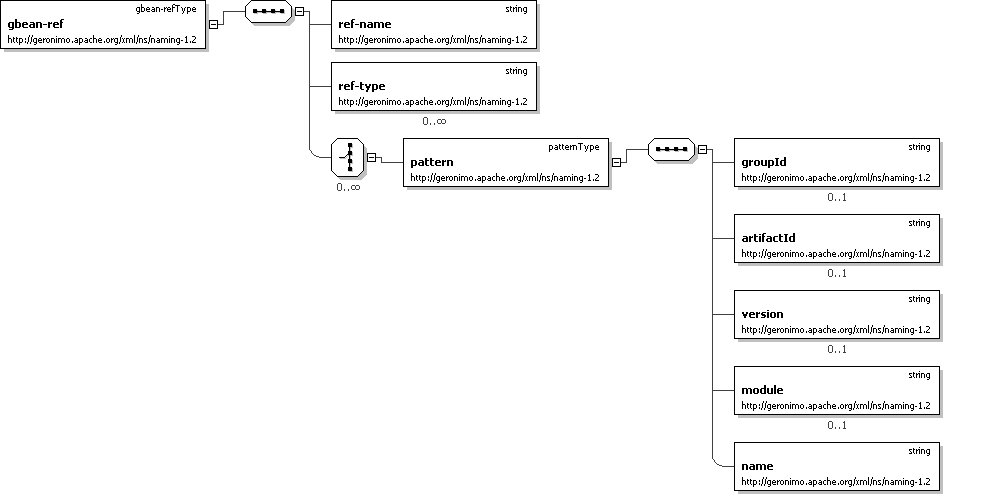
XML Instance Representation
<gernaming:gbean-ref>
<gernaming:ref-name>
xsd:string </gernaming:ref-name> [1]
'The element ref-name is used to identify this gbean reference. This name should be unique in a module and will be used by application to as a part of JNDI name for the referenced gbean. The JNDI name used will be \"java:/comp/env/ref-name. It should map to the \"ref-name\" provided in deployment descriptor.' <gernaming:ref-type>
xsd:string </gernaming:ref-type> [0..*]
Start Choice
[0..*]
'The element ref-type is used to specify the interface implemented by GBean being referenced.' <gernaming:pattern>
gernaming:patternType
</gernaming:pattern> [1]
End Choice
'The element pattern is used to provide additional selection criterion for gbeans if multiple gbeans with same name exists in dependency modules. The pattern mapped should result in single gbean.' </gernaming:gbean-ref>
Diagram
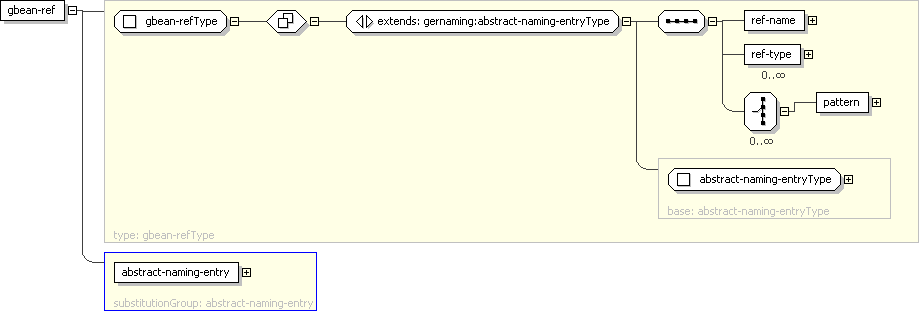
Schema Component Representation
<xsd:element
name="gbean-ref" type="
gernaming:gbean-refType
" substitutionGroup="gernaming:abstract-naming-entry"/>
Element: message-destination
Logical Diagram

XML Instance Representation
<gernaming:message-destination>
<gernaming:message-destination-name>
xsd:string </gernaming:message-destination-name> [1]
Start Choice
[1]
'The element message-destination-name is used to identify this message destination reference. This name should be unique in a module and will be used by application to as a part of JNDI name for the message destination. The JNDI name used will be \"java:/comp/env/ref-name. It should map to the \"message-destination-name\" provided in deployment descriptor.' <gernaming:pattern>
gernaming:patternType
</gernaming:pattern> [1]
'The element pattern is used to provide additional selection criterion for JMS destination\'s if multiple destination\'s with same admin-object-link exists in dependency modules. The pattern mapped should result in single destination.' <gernaming:admin-object-link>
xsd:string </gernaming:admin-object-link> [1]
End Choice
'The element admin-object-link is used to identify the admin object resource specified in any of the dependency modules. This name should match the message-definition-name defined in admin object section of deployment descriptor. If the name is not unique the pattern element will be used to uniquely identify this admin object resource.' </gernaming:message-destination>
Diagram

Schema Component Representation
Element: persistence-context-ref
Logical Diagram
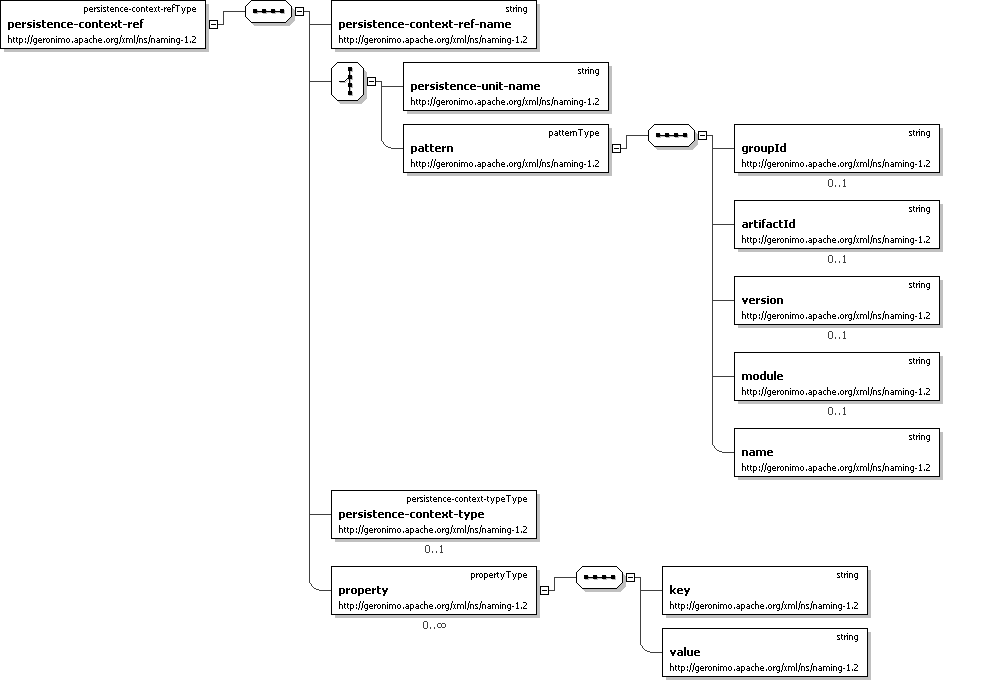
XML Instance Representation
<gernaming:persistence-context-ref>
<gernaming:persistence-context-ref-name>
xsd:string </gernaming:persistence-context-ref-name> [1]
Start Choice
[1]
'The element ref-name is used to identify this persistence context reference. This name should be unique in a module and will be used by application as a part of JNDI name for the referenced persistence context. The JNDI name used will be \"java:/comp/env/ref-name. It should map to the \"ref-name\" provided in deployment descriptor.' <gernaming:persistence-unit-name>
xsd:string </gernaming:persistence-unit-name> [1]
'The element persistence-unit-name is used to identify persistence context specified in any of the dependency modules. This name should match the persistence-unit-name defined in deployment descriptor. If the name is not unique the pattern element will be used to uniquely identify this persistence unit.' <gernaming:pattern>
gernaming:patternType
</gernaming:pattern> [1]
End Choice
'The element pattern is used to provide additional selection criterion for persistence context\'s if multiple persistence context\'s with same persistence-unit-name exists in dependency modules. The pattern mapped should result in single persistence context.' <gernaming:persistence-context-type>
gernaming:persistence-context-typeType
</gernaming:persistence-context-type> [0..1]
'The element persistence-context-type is used to provide transaction features if persistence context reference. It can have value of transaction-scoped or extended.' <gernaming:property>
gernaming:propertyType
</gernaming:property> [0..*]
</gernaming:persistence-context-ref>'The element property is used to provide vendor specific properties for persistence context reference.'
Diagram

Schema Component Representation
<xsd:element
name="persistence-context-ref" type="
gernaming:persistence-context-refType
" substitutionGroup="gernaming:abstract-naming-entry"/>
Element: persistence-unit-ref
Logical Diagram
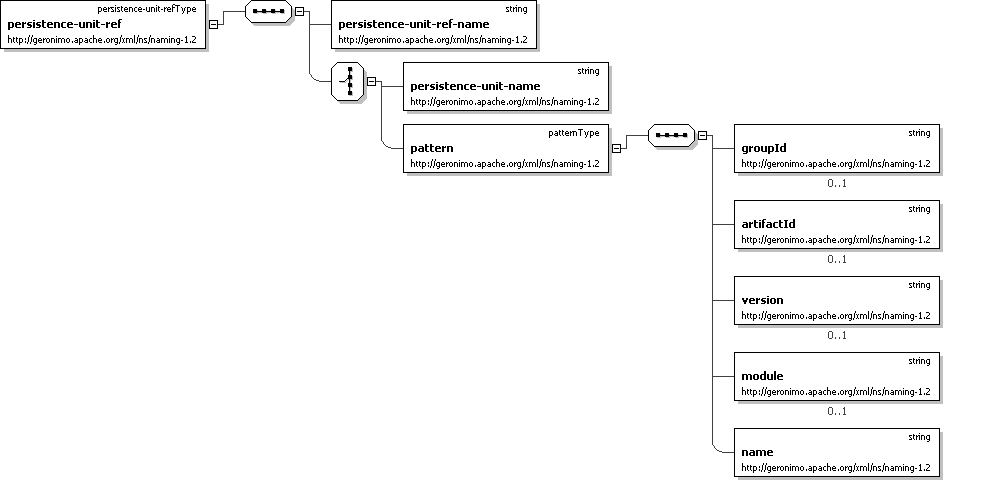
XML Instance Representation
<gernaming:persistence-unit-ref>
<gernaming:persistence-unit-ref-name>
xsd:string </gernaming:persistence-unit-ref-name> [1]
Start Choice
[1]
'The element persistence-unit-ref-name is used to identify this persistence unit reference. This name should be unique in a module and will be used by application as a part of JNDI name for the referenced persistence unit. The JNDI name used will be \"java:/comp/env/ref-name. It should map to the \"ref-name\" provided in deployment descriptor.' <gernaming:persistence-unit-name>
xsd:string </gernaming:persistence-unit-name> [1]
'The element persistence-unit-name is used to identify persistence unit specified in any of the dependency modules. This name should match the persistence-unit-name defined in deployment descriptor. If the name is not unique the pattern element will be used to uniquely identify this persistence unit.' <gernaming:pattern>
gernaming:patternType
</gernaming:pattern> [1]
End Choice
'The element pattern is used to provide additional selection criterion for persistence units if multiple persistence units with same persistence-unit-name exists in dependency modules. The pattern mapped should result in single persistence unit.' </gernaming:persistence-unit-ref>
Diagram

Schema Component Representation
<xsd:element
name="persistence-unit-ref" type="
gernaming:persistence-unit-refType
" substitutionGroup="gernaming:abstract-naming-entry"/>
Element: resource-adapter
Logical Diagram

XML Instance Representation
<gernaming:resource-adapter>
Start Choice [1] <gernaming:pattern>
gernaming:patternType
</gernaming:pattern> [1]
'The element pattern is used to provide additional selection criterion for resources if multiple resources with same resource-name exists in dependency modules. The pattern mapped should result in single resource.' <gernaming:resource-link>
xsd:string </gernaming:resource-link> [1]
'The element resource-link is used to identify the JDBC, JMS, or JavaMail resource specified in all the dependency modules. This name should match the connectiondefination-instance/name defined in resource adapter deployment descriptor. If the name is not unique the pattern element will be used to uniquely identify this resource.' <gernaming:url>
xsd:string </gernaming:url> [1]
End Choice
'The element url is used to identify the resources of type java.net.URL deployed in all the dependency modules. If the url doesn\'t map to unique resource the pattern element will be used to uniquely identify this resource.' </gernaming:resource-adapter>
Diagram

Schema Component Representation
Element: resource-env-ref
Logical Diagram

XML Instance Representation
<gernaming:resource-env-ref>
<gernaming:ref-name>
xsd:string </gernaming:ref-name> [1]
Start Choice
[1]
'The element ref-name is used to identify this resource reference. This name should be unique in a module and will be used by application as a part of JNDI name for the referenced resource. The JNDI name used will be \"java:/comp/env/ref-name. It should map to the \"res-ref-name\" provided in deployment descriptor.' <gernaming:pattern>
gernaming:patternType
</gernaming:pattern> [1]
'The element pattern is used to provide additional selection criterion for admin object\'s if multiple admin object\'s with same admin-object-link exists in dependency modules. The pattern mapped should result in single admin object.' <gernaming:message-destination-link>
xsd:string </gernaming:message-destination-link> [1]
'This element is deprecated and should not be used. Use admin-object-link instead. That is effectively a renamed version of this.' <gernaming:admin-object-link>
xsd:string </gernaming:admin-object-link> [1]
End Choice
'The element admin-object-link is used to identify the admin object resource specified in any of the dependency modules. This name should match the message-definition-name defined in admin object section of deployment descriptor. If the name is not unique the pattern element will be used to uniquely identify this admin object resource.' </gernaming:resource-env-ref>
Diagram

Schema Component Representation
Element: resource-ref
Logical Diagram
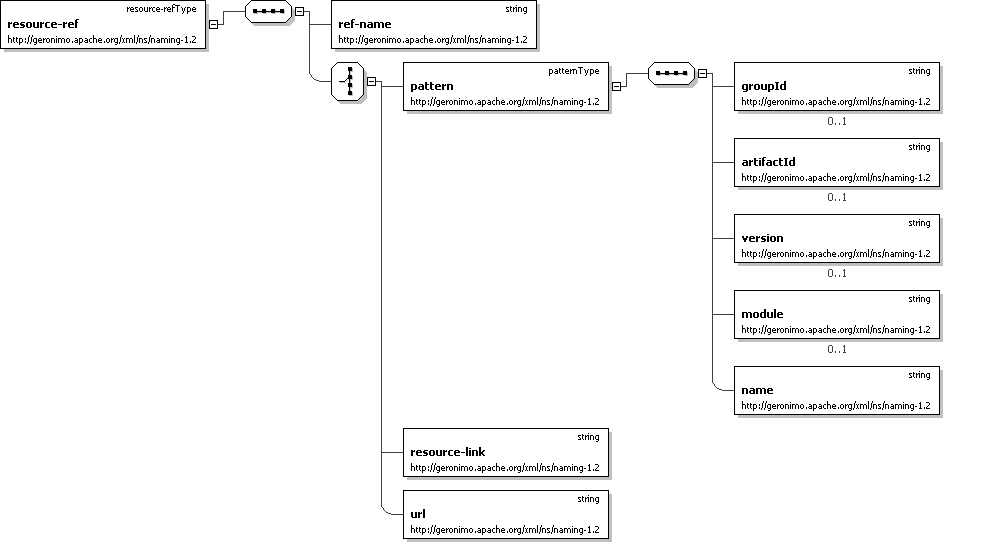
XML Instance Representation
<gernaming:resource-ref>
<gernaming:ref-name>
xsd:string </gernaming:ref-name> [1]
Start Choice
[1]
'The element ref-name is used to identify this resource reference. This name should be unique in a module and will be used by application to as a part of JNDI name for the referenced resource. The JNDI name used will be \"java:/comp/env/ref-name. It should map to the \"resource-ref-name\" provided in deployment descriptor.' <gernaming:pattern>
gernaming:patternType
</gernaming:pattern> [1]
'The element pattern is used to provide additional selection criterion for resources if multiple resources with same resource-link or URI exists dependency modules. The pattern mapped should result in single resource.' <gernaming:resource-link>
xsd:string </gernaming:resource-link> [1]
'The element resource-link is used to identify the JDBC, JMS, or JavaMail resource specified in all the dependency modules. This name should match the connectiondefination-instance/name defined in resource adapter deployment descriptor. If the name is not unique the pattern element will be used to uniquely identify this resource.' <gernaming:url>
xsd:string </gernaming:url> [1]
End Choice
'The element url is used to identify the resources of type java.net.URL deployed in all the dependency modules. If the url doesn\'t map to unique resource the pattern element will be used to uniquely identify this resource.' </gernaming:resource-ref>
Diagram

Schema Component Representation
Element: service-ref
Logical Diagram
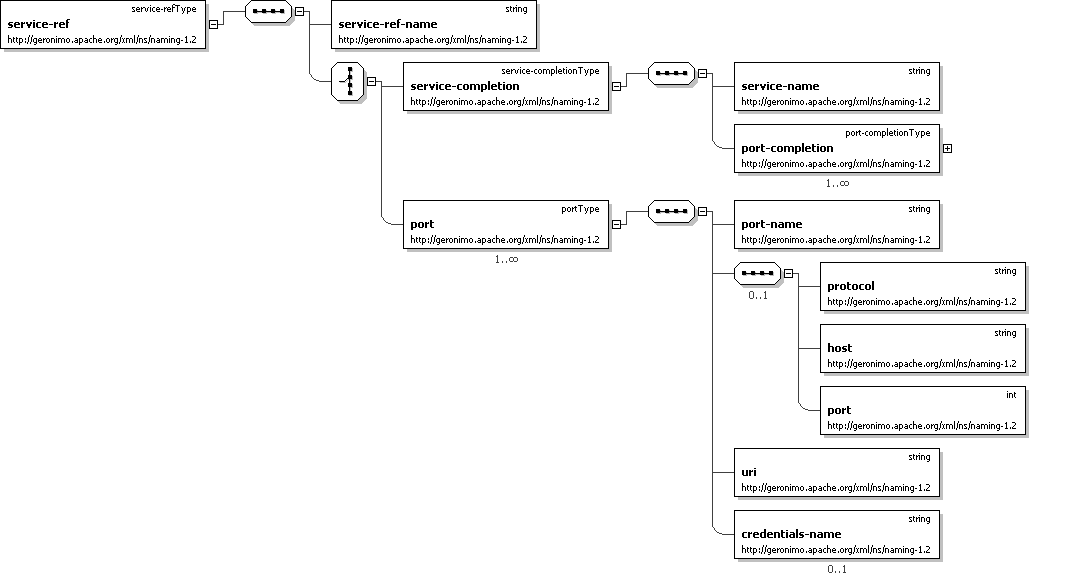
XML Instance Representation
<gernaming:service-ref>
<gernaming:service-ref-name>
xsd:string </gernaming:service-ref-name> [1]
Start Choice
[1]
'The element service-ref-name is used to identify this service reference. This name should be unique in a module and will be used by application to as a part of JNDI name for the web service. The JNDI name used will be \"java:/comp/env/ref-name. It should map to the \"service-ref-name\" provided in service-ref of deployment descriptor.' <gernaming:service-completion>
gernaming:service-completionType
</gernaming:service-completion> [1]
'The element service-completion is used to provide missing information for web service. If this element doesn\'t exist all the information should be available in WSDL.' <gernaming:port>
gernaming:portType
</gernaming:port> [1..*]
End Choice
'The element port defines the ports available though service reference. If this element doesn\'t exist the port information should be available in WSDL.' </gernaming:service-ref>
Diagram

Schema Component Representation
Element: web-container
Logical Diagram
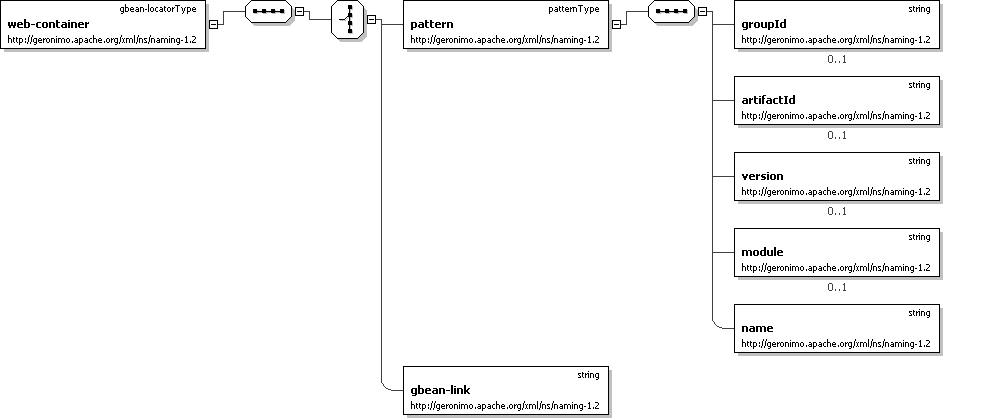
XML Instance Representation
<gernaming:web-container>
Start Choice [1] <gernaming:pattern>
gernaming:patternType
</gernaming:pattern> [1]
'The element pattern is used to provide additional selection criterion for gbean\'s if multiple gbean\'s with same name exists in dependency modules. The pattern mapped should result in single gbean.' <gernaming:gbean-link>
xsd:string </gernaming:gbean-link> [1]
End Choice
'The element gbean-link is used to identify the gbean deployed in any of the dependency modules. This name should match the gbean-name defined in deployment plane. If the name is not unique the pattern element will be used to uniquely identify this gbean.' </gernaming:web-container>
Diagram

Schema Component Representation
Element: workmanager
Logical Diagram
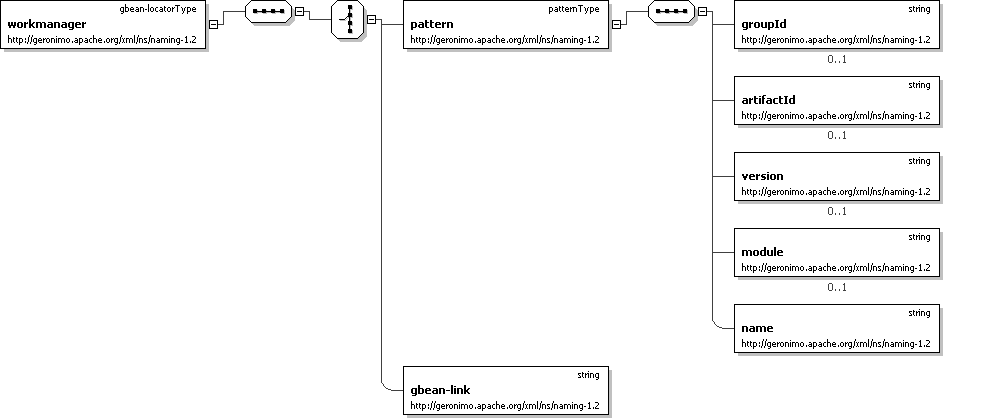
XML Instance Representation
<gernaming:workmanager>
Start Choice [1] <gernaming:pattern>
gernaming:patternType
</gernaming:pattern> [1]
'The element pattern is used to provide additional selection criterion for gbean\'s if multiple gbean\'s with same name exists in dependency modules. The pattern mapped should result in single gbean.' <gernaming:gbean-link>
xsd:string </gernaming:gbean-link> [1]
End Choice
'The element gbean-link is used to identify the gbean deployed in any of the dependency modules. This name should match the gbean-name defined in deployment plane. If the name is not unique the pattern element will be used to uniquely identify this gbean.' </gernaming:workmanager>
Diagram

Schema Component Representation
Global DefinitionsComplex Type: abstract-naming-entryType
XML Instance Representation
<.../>
Diagram

Schema Component Representation
<xsd:complexType
name="abstract-naming-entryType" abstract="true">
<xsd:sequence/> </xsd:complexType>Complex Type: ejb-local-refType
XML Instance Representation
<...>
<gernaming:ref-name>
xsd:string </gernaming:ref-name> [1]
Start Choice
[1]
'The element ref-name is used to identify this local ejb reference. This name should be unique in a module and will be used by application to as a part of JNDI name for the referenced ejb. The JNDI name used will be \"java:/comp/env/ref-name. It should map to the \"ejb-ref-name\" provided in deployment descriptor.' <gernaming:pattern>
gernaming:patternType
</gernaming:pattern> [1]
'The element pattern is used to provide additional selection criterion for local ejb\'s if multiple local ejb\'s with same ejb-link exists in EAR or dependency modules. The pattern mapped should result in single local EJB.' <gernaming:ejb-link>
xsd:string </gernaming:ejb-link> [1]
End Choice
'The element ejb-link is used to identify the local ejb specified in same EAR or dependency modules. This name should match the ejb-name defined in EJB deployment descriptor. If the name is not unique the pattern element will be used to uniquely identify this local ejb.' </...>
Diagram

Schema Component Representation
<xsd:complexType
name="ejb-local-refType">
<xsd:sequence>
</xsd:complexType><xsd:choice>
</xsd:choice> </xsd:sequence>Complex Type: ejb-refType
XML Instance Representation
<...>
<gernaming:ref-name>
xsd:string </gernaming:ref-name> [1]
Start Choice
[1]
'The element ref-name is used to identify this remote ejb reference. This name should be unique in a module and will be used by application as a part of JNDI name for the referenced ejb. The JNDI name used will be \"java:/comp/env/ref-name. It should map to the \"ejb-ref-name\" provided in deployment descriptor.' <gernaming:pattern>
gernaming:patternType
</gernaming:pattern> [1]
'The element pattern is used to provide additional selection criterion for remote ejbs if multiple ejbs with same ejb-link exists in EAR or dependency modules. The pattern mapped should result in single remote EJB.' <gernaming:ns-corbaloc>
xsd:anyURI </gernaming:ns-corbaloc> [1]
Start Choice
[1]
'The corbaloc used to access the CORBA name server.' <gernaming:css>
gernaming:patternType
</gernaming:css> [1]
'The element css provides the gbean name to identify the client security service used.' <gernaming:css-link>
xsd:string </gernaming:css-link> [1]
End Choice
'The css-link identify the client security service by its name.' <gernaming:ejb-link>
xsd:string </gernaming:ejb-link> [1]
End Choice
'The element ejb-link is used to identify the remote ejb specified in same EAR or dependency modules. This name should match the ejb-name defined in EJB deployment descriptor. If the name is not unique the pattern element will be used to uniquely identify this remote ejb.' </...>
Diagram

Schema Component Representation
<xsd:complexType
name="ejb-refType">
<xsd:sequence>
</xsd:complexType><xsd:choice>
</xsd:choice> </xsd:sequence>Complex Type: gbean-locatorType
XML Instance Representation
<...>
Start Choice [1] <gernaming:pattern>
gernaming:patternType
</gernaming:pattern> [1]
'The element pattern is used to provide additional selection criterion for gbean\'s if multiple gbean\'s with same name exists in dependency modules. The pattern mapped should result in single gbean.' <gernaming:gbean-link>
xsd:string </gernaming:gbean-link> [1]
End Choice
'The element gbean-link is used to identify the gbean deployed in any of the dependency modules. This name should match the gbean-name defined in deployment plane. If the name is not unique the pattern element will be used to uniquely identify this gbean.' </...>
Diagram

Schema Component Representation
<xsd:complexType
name="gbean-locatorType">
<xsd:sequence> </xsd:complexType><xsd:choice>
</xsd:choice> </xsd:sequence>Complex Type: gbean-refType
XML Instance Representation
<...>
<gernaming:ref-name>
xsd:string </gernaming:ref-name> [1]
'The element ref-name is used to identify this gbean reference. This name should be unique in a module and will be used by application to as a part of JNDI name for the referenced gbean. The JNDI name used will be \"java:/comp/env/ref-name. It should map to the \"ref-name\" provided in deployment descriptor.' <gernaming:ref-type>
xsd:string </gernaming:ref-type> [0..*]
Start Choice
[0..*]
'The element ref-type is used to specify the interface implemented by GBean being referenced.' <gernaming:pattern>
gernaming:patternType
</gernaming:pattern> [1]
End Choice
'The element pattern is used to provide additional selection criterion for gbeans if multiple gbeans with same name exists in dependency modules. The pattern mapped should result in single gbean.' </...>
Diagram

Schema Component Representation
<xsd:complexType
name="gbean-refType">
<xsd:complexContent> </xsd:complexType><xsd:extension
base="
gernaming:abstract-naming-entryType
"> </xsd:complexContent><xsd:sequence>
</xsd:extension><xsd:choice
minOccurs="0" maxOccurs="unbounded"></xsd:choice> </xsd:sequence>Complex Type: message-destinationType
XML Instance Representation
<...>
<gernaming:message-destination-name>
xsd:string </gernaming:message-destination-name> [1]
Start Choice
[1]
'The element message-destination-name is used to identify this message destination reference. This name should be unique in a module and will be used by application to as a part of JNDI name for the message destination. The JNDI name used will be \"java:/comp/env/ref-name. It should map to the \"message-destination-name\" provided in deployment descriptor.' <gernaming:pattern>
gernaming:patternType
</gernaming:pattern> [1]
'The element pattern is used to provide additional selection criterion for JMS destination\'s if multiple destination\'s with same admin-object-link exists in dependency modules. The pattern mapped should result in single destination.' <gernaming:admin-object-link>
xsd:string </gernaming:admin-object-link> [1]
End Choice
'The element admin-object-link is used to identify the admin object resource specified in any of the dependency modules. This name should match the message-definition-name defined in admin object section of deployment descriptor. If the name is not unique the pattern element will be used to uniquely identify this admin object resource.' </...>
Diagram

Schema Component Representation
<xsd:complexType
name="message-destinationType">
<xsd:sequence>
</xsd:complexType><xsd:choice>
</xsd:sequence><xsd:sequence>
</xsd:sequence> </xsd:choice>Complex Type: patternType
XML Instance Representation
<...>
<gernaming:groupId>
xsd:string </gernaming:groupId> [0..1]
'The name for group containing module to match. By default is it considered wild card \'*\'.' <gernaming:artifactId>
xsd:string </gernaming:artifactId> [0..1]
'The name for module in a specified group to be matched.' <gernaming:version>
xsd:string </gernaming:version> [0..1]
</...>'The version number for the module formatted by dot separated numbers. If no version is provided it will be defaulted latest available version matching other criterions.'
Diagram
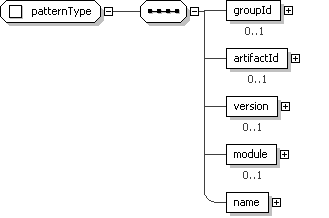
Schema Component Representation
<xsd:complexType
name="patternType">
<xsd:sequence>
</xsd:sequence> </xsd:complexType>Complex Type: persistence-context-refType
XML Instance Representation
<...>
<gernaming:persistence-context-ref-name>
xsd:string </gernaming:persistence-context-ref-name> [1]
Start Choice
[1]
'The element ref-name is used to identify this persistence context reference. This name should be unique in a module and will be used by application as a part of JNDI name for the referenced persistence context. The JNDI name used will be \"java:/comp/env/ref-name. It should map to the \"ref-name\" provided in deployment descriptor.' <gernaming:persistence-unit-name>
xsd:string </gernaming:persistence-unit-name> [1]
'The element persistence-unit-name is used to identify persistence context specified in any of the dependency modules. This name should match the persistence-unit-name defined in deployment descriptor. If the name is not unique the pattern element will be used to uniquely identify this persistence unit.' <gernaming:pattern>
gernaming:patternType
</gernaming:pattern> [1]
End Choice
'The element pattern is used to provide additional selection criterion for persistence context\'s if multiple persistence context\'s with same persistence-unit-name exists in dependency modules. The pattern mapped should result in single persistence context.' <gernaming:persistence-context-type>
gernaming:persistence-context-typeType
</gernaming:persistence-context-type> [0..1]
'The element persistence-context-type is used to provide transaction features if persistence context reference. It can have value of transaction-scoped or extended.' <gernaming:property>
gernaming:propertyType
</gernaming:property> [0..*]
</...>'The element property is used to provide vendor specific properties for persistence context reference.'
Diagram

Schema Component Representation
<xsd:complexType
name="persistence-context-refType">
<xsd:complexContent> </xsd:complexType><xsd:extension
base="
gernaming:abstract-naming-entryType
"> </xsd:complexContent><xsd:sequence>
</xsd:extension><xsd:choice>
</xsd:choice>
<xsd:element
name="persistence-context-type" type="
gernaming:persistence-context-typeType
" minOccurs="0"/>
</xsd:sequence>Complex Type: persistence-unit-refType
XML Instance Representation
<...>
<gernaming:persistence-unit-ref-name>
xsd:string </gernaming:persistence-unit-ref-name> [1]
Start Choice
[1]
'The element persistence-unit-ref-name is used to identify this persistence unit reference. This name should be unique in a module and will be used by application as a part of JNDI name for the referenced persistence unit. The JNDI name used will be \"java:/comp/env/ref-name. It should map to the \"ref-name\" provided in deployment descriptor.' <gernaming:persistence-unit-name>
xsd:string </gernaming:persistence-unit-name> [1]
'The element persistence-unit-name is used to identify persistence unit specified in any of the dependency modules. This name should match the persistence-unit-name defined in deployment descriptor. If the name is not unique the pattern element will be used to uniquely identify this persistence unit.' <gernaming:pattern>
gernaming:patternType
</gernaming:pattern> [1]
End Choice
'The element pattern is used to provide additional selection criterion for persistence units if multiple persistence units with same persistence-unit-name exists in dependency modules. The pattern mapped should result in single persistence unit.' </...>
Diagram

Schema Component Representation
<xsd:complexType
name="persistence-unit-refType">
<xsd:complexContent> </xsd:complexType><xsd:extension
base="
gernaming:abstract-naming-entryType
"> </xsd:complexContent><xsd:sequence>
</xsd:extension><xsd:choice>
</xsd:choice> </xsd:sequence>Complex Type: port-completionType
XML Instance Representation
Diagram

Schema Component Representation
Complex Type: portType
XML Instance Representation
<...>
<gernaming:port-name>
xsd:string </gernaming:port-name> [1]
Start Group: gernaming:serverGroup
[0..1]
'The port-name element provides the name to identify the port to connect.' 'Reference to serverGroup defined later in this schema.' <gernaming:protocol>
xsd:string </gernaming:protocol> [1]
'The protocol element is used to specify the network protocol used for connection. This could be http or https.' <gernaming:host>
xsd:string </gernaming:host> [1]
'The host element is used to specify the network host to connect.' <gernaming:port>
xsd:int </gernaming:port> [1]
End Group: gernaming:serverGroup
'The port element is used to specify the network port to connect.' </...>
Diagram

Schema Component Representation
<xsd:complexType
name="portType">
<xsd:sequence>
</xsd:sequence> </xsd:complexType>Complex Type: propertyType
XML Instance Representation
Diagram

Schema Component Representation
Complex Type: resource-env-refType
XML Instance Representation
<...>
<gernaming:ref-name>
xsd:string </gernaming:ref-name> [1]
Start Choice
[1]
'The element ref-name is used to identify this resource reference. This name should be unique in a module and will be used by application as a part of JNDI name for the referenced resource. The JNDI name used will be \"java:/comp/env/ref-name. It should map to the \"res-ref-name\" provided in deployment descriptor.' <gernaming:pattern>
gernaming:patternType
</gernaming:pattern> [1]
'The element pattern is used to provide additional selection criterion for admin object\'s if multiple admin object\'s with same admin-object-link exists in dependency modules. The pattern mapped should result in single admin object.' <gernaming:message-destination-link>
xsd:string </gernaming:message-destination-link> [1]
'This element is deprecated and should not be used. Use admin-object-link instead. That is effectively a renamed version of this.' <gernaming:admin-object-link>
xsd:string </gernaming:admin-object-link> [1]
End Choice
'The element admin-object-link is used to identify the admin object resource specified in any of the dependency modules. This name should match the message-definition-name defined in admin object section of deployment descriptor. If the name is not unique the pattern element will be used to uniquely identify this admin object resource.' </...>
Diagram

Schema Component Representation
<xsd:complexType
name="resource-env-refType">
<xsd:sequence>
</xsd:complexType><xsd:choice>
</xsd:sequence><xsd:sequence>
</xsd:sequence> </xsd:choice>Complex Type: resource-locatorType
XML Instance Representation
<...>
Start Choice [1] <gernaming:pattern>
gernaming:patternType
</gernaming:pattern> [1]
'The element pattern is used to provide additional selection criterion for resources if multiple resources with same resource-name exists in dependency modules. The pattern mapped should result in single resource.' <gernaming:resource-link>
xsd:string </gernaming:resource-link> [1]
'The element resource-link is used to identify the JDBC, JMS, or JavaMail resource specified in all the dependency modules. This name should match the connectiondefination-instance/name defined in resource adapter deployment descriptor. If the name is not unique the pattern element will be used to uniquely identify this resource.' <gernaming:url>
xsd:string </gernaming:url> [1]
End Choice
'The element url is used to identify the resources of type java.net.URL deployed in all the dependency modules. If the url doesn\'t map to unique resource the pattern element will be used to uniquely identify this resource.' </...>
Diagram

Schema Component Representation
<xsd:complexType
name="resource-locatorType">
<xsd:sequence> </xsd:complexType><xsd:choice>
</xsd:choice> </xsd:sequence>Complex Type: resource-refType
XML Instance Representation
<...>
<gernaming:ref-name>
xsd:string </gernaming:ref-name> [1]
Start Choice
[1]
'The element ref-name is used to identify this resource reference. This name should be unique in a module and will be used by application to as a part of JNDI name for the referenced resource. The JNDI name used will be \"java:/comp/env/ref-name. It should map to the \"resource-ref-name\" provided in deployment descriptor.' <gernaming:pattern>
gernaming:patternType
</gernaming:pattern> [1]
'The element pattern is used to provide additional selection criterion for resources if multiple resources with same resource-link or URI exists dependency modules. The pattern mapped should result in single resource.' <gernaming:resource-link>
xsd:string </gernaming:resource-link> [1]
'The element resource-link is used to identify the JDBC, JMS, or JavaMail resource specified in all the dependency modules. This name should match the connectiondefination-instance/name defined in resource adapter deployment descriptor. If the name is not unique the pattern element will be used to uniquely identify this resource.' <gernaming:url>
xsd:string </gernaming:url> [1]
End Choice
'The element url is used to identify the resources of type java.net.URL deployed in all the dependency modules. If the url doesn\'t map to unique resource the pattern element will be used to uniquely identify this resource.' </...>
Diagram

Schema Component Representation
<xsd:complexType
name="resource-refType">
<xsd:sequence>
</xsd:complexType><xsd:choice>
</xsd:choice> </xsd:sequence>Complex Type: service-completionType
XML Instance Representation
<...>
<gernaming:service-name>
xsd:string </gernaming:service-name> [1]
'The element service-name provides the name of the service missing in service block of WSDL.' <gernaming:port-completion>
gernaming:port-completionType
</gernaming:port-completion> [1..*]
</...>'The element port-completion provides the port information missing in WSDL.'
Diagram

Schema Component Representation
<xsd:complexType
name="service-completionType">
<xsd:sequence>
</xsd:sequence> </xsd:complexType>Complex Type: service-refType
XML Instance Representation
<...>
<gernaming:service-ref-name>
xsd:string </gernaming:service-ref-name> [1]
Start Choice
[1]
'The element service-ref-name is used to identify this service reference. This name should be unique in a module and will be used by application to as a part of JNDI name for the web service. The JNDI name used will be \"java:/comp/env/ref-name. It should map to the \"service-ref-name\" provided in service-ref of deployment descriptor.' <gernaming:service-completion>
gernaming:service-completionType
</gernaming:service-completion> [1]
'The element service-completion is used to provide missing information for web service. If this element doesn\'t exist all the information should be available in WSDL.' <gernaming:port>
gernaming:portType
</gernaming:port> [1..*]
End Choice
'The element port defines the ports available though service reference. If this element doesn\'t exist the port information should be available in WSDL.' </...>
Diagram

Schema Component Representation
<xsd:complexType
name="service-refType">
<xsd:sequence>
</xsd:complexType><xsd:choice>
</xsd:choice> </xsd:sequence>Model Group: corbaNameGroup
XML Instance Representation
<gernaming:ns-corbaloc>
xsd:anyURI </gernaming:ns-corbaloc> [1]
Start Choice
[1]
'The corbaloc used to access the CORBA name server.' <gernaming:css>
gernaming:patternType
</gernaming:css> [1]
'The element css provides the gbean name to identify the client security service used.' <gernaming:css-link>
xsd:string </gernaming:css-link> [1]
End Choice
'The css-link identify the client security service by its name.'
Diagram

Schema Component Representation
<xsd:group
name="corbaNameGroup">
<xsd:sequence>
</xsd:group><xsd:choice>
</xsd:choice> </xsd:sequence>Model Group: jndiEnvironmentRefsGroup
XML Instance Representation
<gernaming:ejb-ref>
gernaming:ejb-refType
</gernaming:ejb-ref> [0..*]
'The element ejb-ref is used to map EJB references to EJB\'s in other applications using remote home and remote interface. The application which contains the EJB being referenced should either be in same EAR or should be included in dependency list of this application. Also note as the EJB\'s referenced are in a different JVM all the Client interfaces should also be included in current application.' <gernaming:ejb-local-ref>
gernaming:ejb-local-refType
</gernaming:ejb-local-ref> [0..*]
'The element ejb-local-ref is used to map EJB references to EJB\'s in other applications using local home and local interface. The application which contains the EJB being referenced should either be in same EAR or should be included in dependency list of this application. Also note as the EJB\'s referenced are in a different JVM all the Client interfaces should also be included in current application.' <gernaming:service-ref>
gernaming:service-refType
</gernaming:service-ref> [0..*]
'The element service-ref is used to map service references to service\'s in other applications. The application which contains the EJB being referenced should either be in same EAR or should be included in dependency list of this application.' <gernaming:resource-ref>
gernaming:resource-refType
</gernaming:resource-ref> [0..*]
'The element resource-ref is used to map resource references to resources\'s like JDBC resources, JMS resources, etc. configured outside the current application.' <gernaming:resource-env-ref>
gernaming:resource-env-refType
</gernaming:resource-env-ref> [0..*]
'The element resource-env-ref is used to map resource references to administrative objects deployed as a part of connectors.'
Diagram
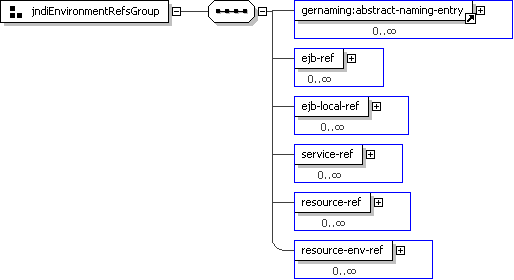
Schema Component Representation
<xsd:group
name="jndiEnvironmentRefsGroup">
<xsd:sequence>
</xsd:group><xsd:element
name="ejb-local-ref" type="
gernaming:ejb-local-refType
" minOccurs="0" maxOccurs="unbounded"/>
<xsd:element
name="service-ref" type="
gernaming:service-refType
" minOccurs="0" maxOccurs="unbounded"/>
<xsd:element
name="resource-ref" type="
gernaming:resource-refType
" minOccurs="0" maxOccurs="unbounded"/>
<xsd:element
name="resource-env-ref" type="
gernaming:resource-env-refType
" minOccurs="0" maxOccurs="unbounded"/> </xsd:sequence>Model Group: serverGroup
XML Instance Representation
Diagram

Schema Component Representation
Simple Type: persistence-context-typeType
Diagram

Schema Component Representation
<xsd:simpleType
name="persistence-context-typeType">
<xsd:restriction
base="
xsd:string
"> </xsd:simpleType><xsd:enumeration
value="Transactional"/>
<xsd:enumeration
value="Extended"/> </xsd:restriction>LegendComplex Type:Schema Component Type
AusAddressSchema Component Name
If this schema component is a type definition, its type hierarchy is shown in a gray-bordered box.
The table above displays the properties of this schema component.
XML Instance Representation
<...
country="Australia"
>
<unitNo> string </unitNo> [0..1] <houseNo> string </houseNo> [1] <street> string </street> [1] Start Choice [1] <city> string </city> [1] <town> string </town> [1] End Choice <state> AusStates </state> [1] <postcode> string <<pattern = [1-9][0-9]{3}>> </postcode> [1] ? </...> The XML Instance Representation table above shows the schema component's content as an XML instance.
Schema Component Representation
<complexType
name="AusAddress">
<complexContent> <extension base=" Address "> <sequence> <element name="state" type=" AusStates "/> <element name="postcode"> <simpleType> <restriction base=" string "> <pattern value="[1-9][0-9]{3}"/> </restriction> </simpleType> </element> </sequence> <attribute name="country" type=" string " fixed="Australia"/> </extension> </complexContent> </complexType> The Schema Component Representation table above displays the underlying XML representation of the schema component. (Annotations are not shown.)
GlossaryAbstract (Applies to complex type definitions and element declarations). An abstract element or complex type cannot used to validate an element instance. If there is a reference to an abstract element, only element declarations that can substitute the abstract element can be used to validate the instance. For references to abstract type definitions, only derived types can be used. All Model Group Child elements can be provided in any order in instances. See: http://www.w3.org/TR/xmlschema-1/#element-all. Choice Model Group Only one from the list of child elements and model groups can be provided in instances. See: http://www.w3.org/TR/xmlschema-1/#element-choice. Collapse Whitespace Policy Replace tab, line feed, and carriage return characters with space character (Unicode character 32). Then, collapse contiguous sequences of space characters into single space character, and remove leading and trailing space characters.
Disallowed Substitutions
(Applies to element declarations). If substitution is specified, then substitution group members cannot be used in place of the given element declaration to validate element instances. If derivation methods, e.g. extension, restriction, are specified, then the given element declaration will not validate element instances that have types derived from the element declaration's type using the specified derivation methods. Normally, element instances can override their declaration's type by specifying an Key Constraint Like Uniqueness Constraint, but additionally requires that the specified value(s) must be provided. See: http://www.w3.org/TR/xmlschema-1/#cIdentity-constraint_Definitions. Key Reference Constraint Ensures that the specified value(s) must match value(s) from a Key Constraint or Uniqueness Constraint. See: http://www.w3.org/TR/xmlschema-1/#cIdentity-constraint_Definitions. Model Group Groups together element content, specifying the order in which the element content can occur and the number of times the group of element content may be repeated. See: http://www.w3.org/TR/xmlschema-1/#Model_Groups.
Nillable
(Applies to element declarations). If an element declaration is nillable, instances can use the Notation A notation is used to identify the format of a piece of data. Values of elements and attributes that are of type, NOTATION, must come from the names of declared notations. See: http://www.w3.org/TR/xmlschema-1/#cNotation_Declarations. Preserve Whitespace Policy Preserve whitespaces exactly as they appear in instances. Prohibited Derivations (Applies to type definitions). Derivation methods that cannot be used to create sub-types from a given type definition. Prohibited Substitutions (Applies to complex type definitions). Prevents sub-types that have been derived using the specified derivation methods from validating element instances in place of the given type definition. Replace Whitespace Policy Replace tab, line feed, and carriage return characters with space character (Unicode character 32). Sequence Model Group Child elements and model groups must be provided in the specified order in instances. See: http://www.w3.org/TR/xmlschema-1/#element-sequence. Substitution Group Elements that are members of a substitution group can be used wherever the head element of the substitution group is referenced. Substitution Group Exclusions (Applies to element declarations). Prohibits element declarations from nominating themselves as being able to substitute a given element declaration, if they have types that are derived from the original element's type using the specified derivation methods. Target Namespace The target namespace identifies the namespace that components in this schema belongs to. If no target namespace is provided, then the schema components do not belong to any namespace. Uniqueness Constraint Ensures uniqueness of an element/attribute value, or a combination of values, within a specified scope. See: http://www.w3.org/TR/xmlschema-1/#cIdentity-constraint_Definitions. |